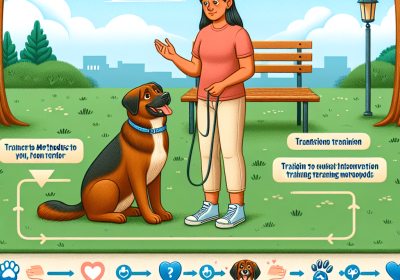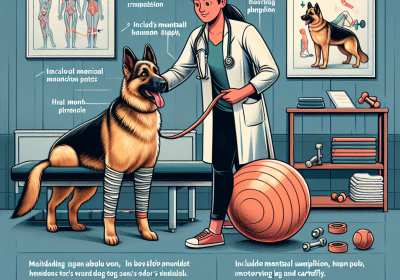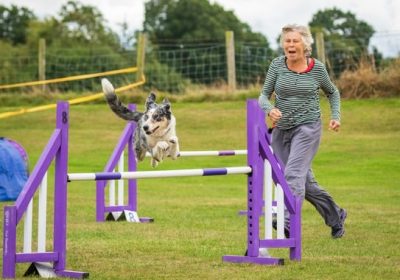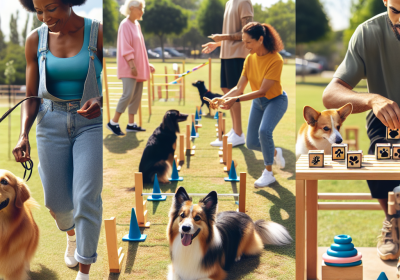Overcoming Mental Challenges in Canine Freework
Table of Contents
- Techniques for Building Confidence in Canine Freework
- Addressing Anxiety in Dogs During Freework Sessions
- Strategies for Managing Distractions in Canine Freework
Overcoming mental challenges in canine freework involves addressing the psychological and emotional hurdles that dogs may face during training and performance. Canine freework, which includes activities such as agility, obedience, and trick training, requires dogs to be mentally focused, confident, and resilient. Mental challenges can arise from various sources, including past traumas, lack of socialization, or anxiety. Effective strategies to overcome these challenges include positive reinforcement, gradual desensitization, and creating a supportive and stress-free environment. By understanding and addressing the mental needs of dogs, trainers can help them achieve their full potential in freework activities, leading to improved performance and a stronger bond between the dog and handler.
Techniques for Building Confidence in Canine Freework
Overcoming mental challenges in canine freework requires a multifaceted approach that emphasizes building confidence through structured techniques. One of the primary methods to achieve this is through positive reinforcement, which plays a crucial role in encouraging desired behaviors and fostering a sense of accomplishment in dogs. By rewarding dogs with treats, praise, or playtime when they successfully complete a task, trainers can create a positive association with the activity, thereby enhancing the dog’s confidence and willingness to engage in freework.
In addition to positive reinforcement, gradual exposure to new environments and stimuli is essential. Dogs, much like humans, can experience anxiety when faced with unfamiliar situations. To mitigate this, trainers should introduce new elements slowly and systematically. For instance, if a dog is hesitant to navigate an obstacle course, breaking down the course into smaller, manageable sections can help. By allowing the dog to master each section individually before combining them, trainers can prevent overwhelming the dog and build its confidence incrementally.
Another effective technique is the use of desensitization and counter-conditioning. This involves exposing the dog to a low-intensity version of a stimulus that causes fear or anxiety and gradually increasing the intensity as the dog becomes more comfortable. For example, if a dog is afraid of loud noises, starting with soft sounds and gradually increasing the volume can help the dog acclimate without becoming overly stressed. Coupled with positive reinforcement, this method can significantly reduce fear responses and build confidence.
Moreover, consistency in training is paramount. Dogs thrive on routine and predictability, which provide a sense of security. Consistent training schedules, commands, and rewards help dogs understand what is expected of them and what they can expect in return. This predictability reduces anxiety and builds a foundation of trust between the dog and the trainer, which is essential for successful freework.
Incorporating play into training sessions can also be highly beneficial. Play not only serves as a reward but also helps to alleviate stress and create a positive training environment. Interactive games that require problem-solving, such as puzzle toys or hide-and-seek, can stimulate a dog’s mind and build confidence in its abilities. Additionally, play can strengthen the bond between the dog and the trainer, making the dog more receptive to learning and more resilient in the face of challenges.
Furthermore, it is important to recognize and respect each dog’s individual limits and progress at a pace that is comfortable for them. Pushing a dog too quickly can lead to setbacks and increased anxiety. Instead, trainers should celebrate small victories and be patient with the dog’s learning process. This approach not only builds confidence but also ensures that the dog remains engaged and motivated.
Lastly, seeking professional guidance can be invaluable, especially for dogs with significant behavioral issues or anxiety. Professional trainers and behaviorists can provide tailored strategies and support, helping to address specific challenges and build a comprehensive training plan. Their expertise can make a substantial difference in overcoming mental challenges and achieving success in canine freework.
In conclusion, building confidence in canine freework involves a combination of positive reinforcement, gradual exposure, desensitization, consistency, play, patience, and professional guidance. By employing these techniques, trainers can help dogs overcome mental challenges, fostering a confident and capable canine partner.
Addressing Anxiety in Dogs During Freework Sessions

Addressing anxiety in dogs during freework sessions is a crucial aspect of ensuring their overall well-being and success in these activities. Freework, a form of canine enrichment that allows dogs to explore and interact with their environment at their own pace, can be highly beneficial for their mental and physical health. However, for some dogs, the freedom and unpredictability of freework can trigger anxiety, making it essential for handlers to recognize and address these challenges effectively.
To begin with, understanding the root causes of anxiety in dogs is fundamental. Anxiety in dogs can stem from various sources, including past traumatic experiences, lack of socialization, or even genetic predispositions. Recognizing the signs of anxiety, such as excessive panting, trembling, avoidance behaviors, or aggression, is the first step in addressing these issues. By identifying these symptoms early, handlers can take proactive measures to create a more supportive environment for their canine companions.
One effective strategy for mitigating anxiety during freework sessions is gradual desensitization. This involves slowly introducing the dog to the freework environment and activities, allowing them to acclimate at their own pace. For instance, starting with short sessions in a familiar and controlled setting can help build the dog’s confidence. Gradually increasing the complexity and duration of the sessions can further ease their anxiety. Throughout this process, it is essential to monitor the dog’s behavior closely and adjust the pace accordingly to prevent overwhelming them.
In addition to desensitization, positive reinforcement plays a pivotal role in addressing anxiety. Rewarding the dog with treats, praise, or play for displaying calm and confident behavior can reinforce their sense of security. This approach not only helps in reducing anxiety but also strengthens the bond between the dog and the handler. Consistency in using positive reinforcement techniques is key to achieving long-term success.
Moreover, creating a safe and predictable environment during freework sessions can significantly alleviate anxiety. Ensuring that the area is free from potential stressors, such as loud noises or unfamiliar objects, can help the dog feel more at ease. Additionally, providing a designated safe space, such as a crate or a quiet corner, where the dog can retreat if they feel overwhelmed, can offer them a sense of control and security.
Another important aspect to consider is the handler’s demeanor and behavior. Dogs are highly perceptive and can pick up on their handler’s emotions. Therefore, maintaining a calm and composed attitude during freework sessions is crucial. Handlers should avoid displaying frustration or impatience, as this can exacerbate the dog’s anxiety. Instead, using a soothing tone of voice and gentle body language can help create a reassuring atmosphere.
Furthermore, incorporating mental and physical exercises that cater to the dog’s individual needs can be beneficial. Activities such as scent work, puzzle toys, or gentle agility exercises can provide mental stimulation and a sense of accomplishment. Tailoring these activities to the dog’s preferences and abilities can enhance their engagement and reduce anxiety.
In conclusion, addressing anxiety in dogs during freework sessions requires a multifaceted approach that includes understanding the root causes, gradual desensitization, positive reinforcement, creating a safe environment, and maintaining a calm demeanor. By implementing these strategies, handlers can help their canine companions overcome mental challenges and fully enjoy the benefits of freework. Ultimately, fostering a supportive and empathetic environment will not only enhance the dog’s well-being but also strengthen the bond between the dog and the handler.
Strategies for Managing Distractions in Canine Freework
In the realm of canine freework, managing distractions is a pivotal aspect that can significantly influence the success of training sessions. Distractions, whether environmental or internal, can impede a dog’s ability to focus and perform tasks effectively. Therefore, implementing strategies to overcome these mental challenges is essential for both trainers and their canine companions. One effective approach is to gradually introduce distractions in a controlled manner. By starting with minimal distractions and progressively increasing their complexity, dogs can learn to maintain focus despite external stimuli. This method, often referred to as desensitization, helps dogs build resilience and adaptability, which are crucial for successful freework.
Another key strategy involves the use of positive reinforcement. Rewarding dogs for maintaining focus amidst distractions reinforces desired behaviors and encourages them to ignore irrelevant stimuli. This can be achieved through treats, praise, or play, depending on what motivates the individual dog. Consistency in reinforcement is vital, as it helps dogs understand the connection between their actions and the rewards they receive. Additionally, incorporating short, frequent training sessions can prevent mental fatigue and keep dogs engaged. Over time, this approach can significantly enhance a dog’s ability to concentrate during more extended periods of freework.
Moreover, creating a structured training environment can also mitigate the impact of distractions. Establishing a designated training area with minimal external stimuli allows dogs to associate that space with focus and work. This environment can serve as a safe haven where dogs feel secure and are less likely to be distracted. Gradually, as dogs become more proficient in this controlled setting, trainers can introduce them to more challenging environments, thereby generalizing their ability to manage distractions across different contexts.
Furthermore, understanding the individual dog’s triggers and thresholds is crucial. Each dog has unique sensitivities and tolerance levels for distractions. By observing and identifying these factors, trainers can tailor their approach to suit the specific needs of their canine partners. For instance, some dogs may be more reactive to visual stimuli, while others may be more sensitive to sounds or scents. Addressing these individual differences ensures that training is both effective and humane, fostering a positive learning experience for the dog.
In addition to these strategies, mental stimulation and enrichment play a significant role in managing distractions. Engaging dogs in activities that challenge their cognitive abilities can improve their overall focus and problem-solving skills. Puzzle toys, scent work, and interactive games are excellent tools for providing mental stimulation. These activities not only keep dogs mentally sharp but also help them develop the ability to concentrate amidst distractions. Incorporating such enrichment into daily routines can have a lasting impact on a dog’s capacity to manage distractions during freework.
Lastly, the role of the trainer cannot be overstated. A calm, patient, and consistent approach from the trainer sets the tone for the training sessions. Dogs are highly perceptive and can pick up on their handler’s emotions and energy. Therefore, maintaining a composed demeanor and providing clear, consistent cues can help dogs feel more secure and focused. Building a strong bond based on trust and mutual respect further enhances the effectiveness of training, as dogs are more likely to respond positively to a handler they trust.
In conclusion, overcoming mental challenges in canine freework requires a multifaceted approach that includes gradual desensitization, positive reinforcement, structured environments, individualized strategies, mental enrichment, and a composed trainer. By implementing these strategies, trainers can effectively manage distractions, thereby enhancing the performance and well-being of their canine companions.
Read more about Canine Freework
Canine Freework and Mental Stimulation
– The Importance of Mental Stimulation for Dogs
– How Canine Freework Can Provide Mental Stimulation
– Creating Challenging Canine Freework Tasks for Dogs
– Combining Canine Freework with Mental Exercises
– Overcoming Mental Challenges in Canine Freework







![The Dog Podcast Uncovers Startling Truths About What We Feed Our Dogs [Press Release]](https://wordcraftershub.com.au/wp-content/uploads/2024/08/dalmatian-dog-food-400x280.jpg)

